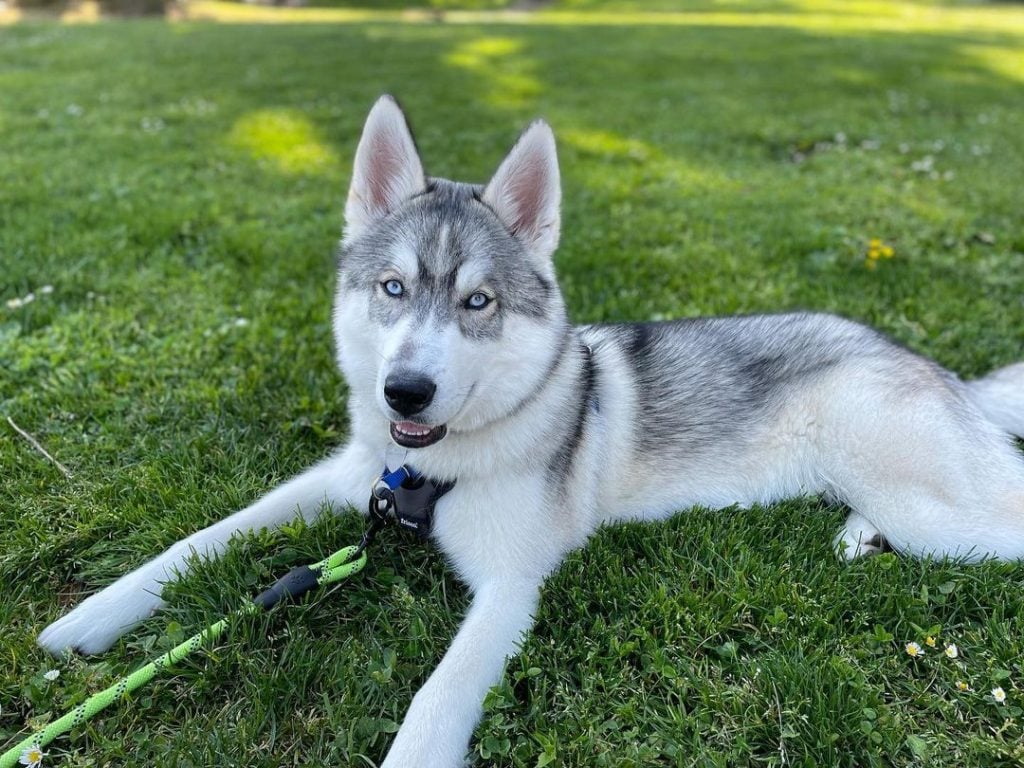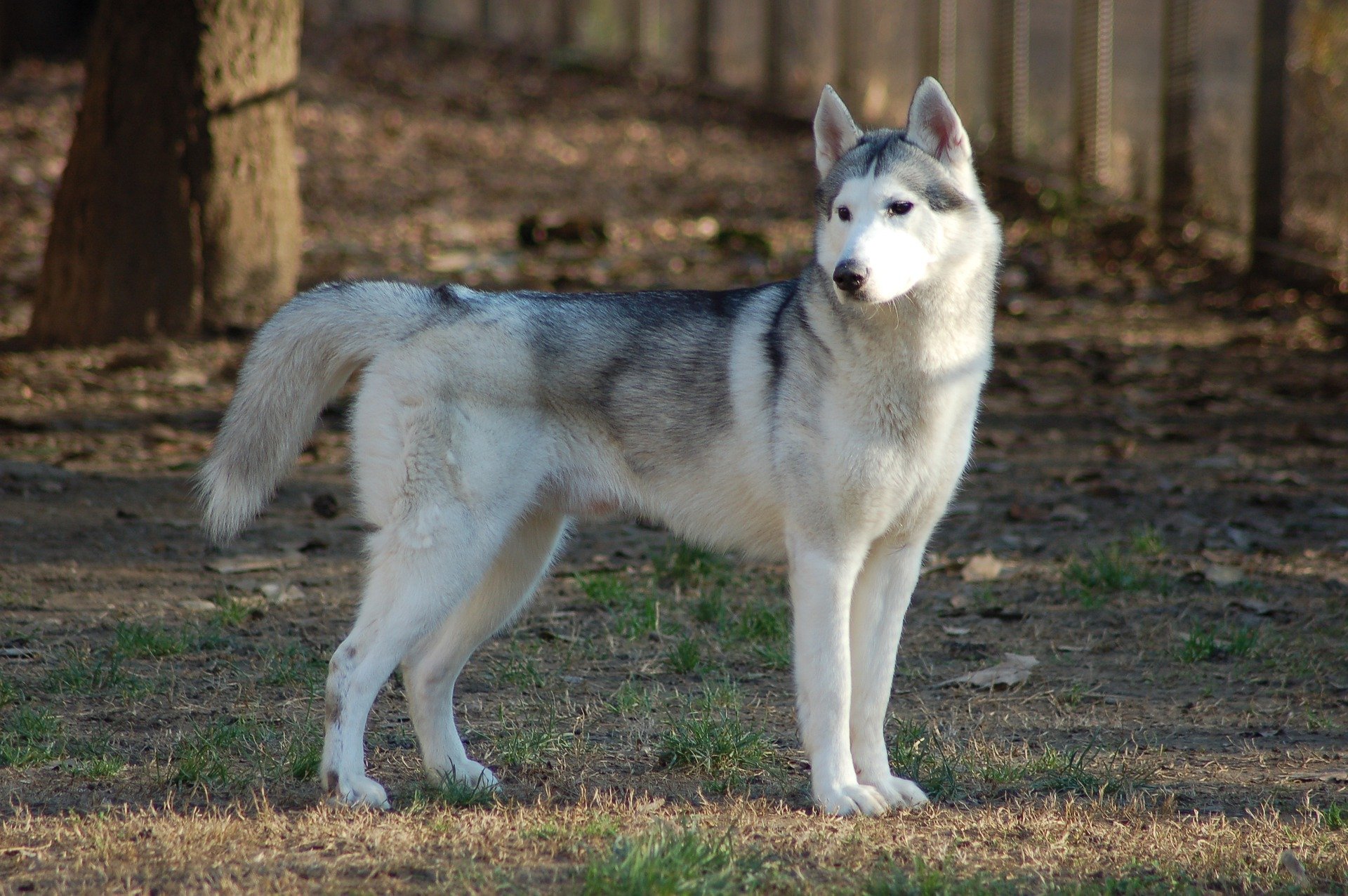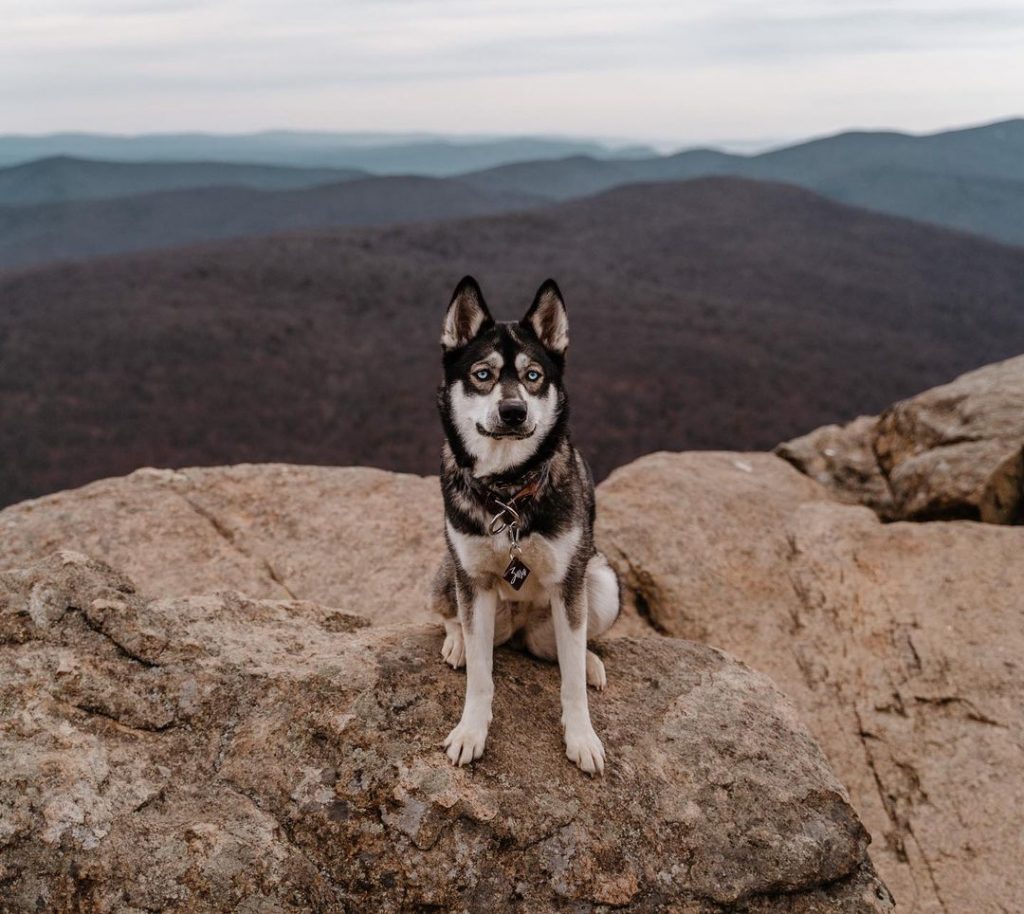Big hearts, fluffy bodies and sometimes humorous markings around their eyes make Huskies exceptionally appealing dogs. These distinctive looking, strong but gentle natured dogs are usually associated with snow-sledding but have become a popular household pet across the world, as well as right here in the United States. This is a breed that has journeyed across the world from their origins in north-eastern Asia, right into the hearts of millions of fans, and now into the rankings of most popular breeds in the country. Jump aboard the sled and get to know the Siberian Husky.

Breed Characteristics
Key
- Low
- Medium
- High
- Origin: Russia
- Size:
- Weight: 35 to 60 pounds
- Activity level:
- Barking/howling level:
- Good with dogs: yes
- Good with kids: yes
- Good with cats:
- Shedding:
- Grooming level:
- Training level:
Siberian Husky Appearance

It’s hard to miss a Siberian Husky–they have many distinctive breed features and a Husky is certainly one handsome dog. However, they do share some common traits with other dogs, and can, to an untrained eye, sometimes be mistaken for malamutes or even German Shepherds.
When you think of a Husky, you probably immediately visualize a medium-sized dog, with a proud long nose and upright ears, set on a roundish but well-proportioned head, and, at the other end, a big bushy “brush” tail, with a thick coat on their bodies. You’d be spot on. You might even say they somewhat resembled a wolf. The Siberian Husky is a stunning dog, with piercing eyes that can be bright blue, sometimes brown, and sometimes a mixture of both colors. Their faces are usually white, framed with darker–usually black or brown–markings. These markings can form patterns on their faces which can lend a Husky a whimsical or amusing expression. According to the AKC Husky breed standard, you’ll find Huskies in a range of color combinations, from pure black to white, and in between; brown, sable, black-tan, red and even agouti variations, which is a kind of hair color apparently desirable for camouflage in the wild. Camo action Huskies! We’ll wager you won’t find a more super-action dog than this.
First bred as sled dogs who could endure long journeys through the tundra, they have a thick double coat, which sheds seasonally like other double-coated dogs.
Siberian Husky Personality
Since they were bred specifically to run, work and pull all day long, Siberian Huskies are most definitely on the higher-energy end of the spectrum. They also have a tendency to be independent minded, which is surprising considering their history as pack dogs. As outdoorsy and hard working as these dogs are, you’ll find Huskies are good natured, gentle dogs who love the company of their humans, without being too clingy or needy. Their high energy, intelligence and friendly nature also make them great therapy dogs.
Siberian Husky Environment
Since Huskies are such active dogs, they’d ideally have a garden to play and run freely in, as long as it’s well secured; Huskies are infamous for their escape artistry. You can live with a Husky in an apartment, but it’s important for you and them to get out regularly to get enough exercise. A Husky will fit in well with other dogs, cats and children, provided they’re socialized well from an early age. In spite of that famous thick double coat of theirs, Huskies are adaptable to warmer climates, provided they don’t over exert themselves and are given ample opportunity to cool down.
Ideal Human for a Siberian Husky
Siberian Huskies were originally bred for protection and sled pulling duties in harsh environments, but that doesn’t mean you need to belong to a nomadic tribe to give a Husky a good home. Considering their background as working dogs, Huskies are very gentle natured and affectionate dogs, who long to be with their families, so having plenty of time to spend with your dog is a must.
A Siberian Husky will be a natural fit to your family if you’re active, and if all members of your family or household are willing to keep a good level of consistency in training, and a watchful eye on your dog if they’re playing in the garden, and whilst out on walks. If you’re looking for a dog who’ll keep you busy, and perhaps who might want company on a walk, run or hike (remember to keep them on leash–they are fast and have a habit of chasing small animals) then a Husky will be at home with you.
Siberian Husky Training
It would be fair to say that Siberian Huskies have something of a reputation for being challenging to train. You can probably put this down to their intelligence and history of running as a sled dog, so, unless you’re working your Husky very hard, it’s probable that most domestic Huskies don’t get the same level of exercise their ancestors did.
One interesting note–and there’s a clue–about Huskies is that they don’t really bark, which is great…until you learn about their love for other types of vocalisations. They love to howl, oh yes. Their vocal prowess can be anything from incredibly amusing (the stuff of viral videos) to a downright nuisance.
A Husky’s independent streak can make them a handful when it comes to training; you might find your Husky has a very different idea of what he thinks is going to happen during a training session. Starting them from a young age, with plenty of confidence and routine should do the trick; of course, some experience training more challenging dogs can also help.
Huskies are also sometimes called the “houdini hound”, due to their love of using your garden or yard to practice their latest escape hijinks, including digging. In fact, some Huskies can become destructive if not given enough to occupy their minds and bodies. Keeping your Husky well exercised, and well entertained with puzzle toys, or giving them a specific job to do can help alleviate the boredom and excess energy that leads to this type of behavior.
Siberian Husky Grooming
We’ve already mentioned that famous double coat, which sheds seasonally like other double-coated dogs. But Huskies have a very particular shedding schedule; their inner coat drops very quickly and in a short frame of time, sometimes as little as a week or two. You might find yourself with a vast quantity of hair on your hands during the shedding seasons of spring and fall. So be prepared to do a heavy amount of both brushing of your dog, and home furnishings. If you need an extra hand choosing a vacuum cleaner up to the job, we’ve reviewed the very best machines for you here.
On the other hand, Siberian Huskies are famously fastidiously clean dogs who groom themselves much like cats do. This means they don’t smell and rarely need a bath. Bonus!

Siberian Husky Health
Siberian Huskies are a generally pretty healthy breed. However, like all dogs, Huskies are prone to certain health issues. This includes hip dysplasia and eye diseases. One thing to note is that they’re able to maintain a healthy weight on less food than most dogs their size, so check in with your vet about the right amount of food to give your Husky, and try to avoid over-treating. Pro tip: weigh out the total food required for a day and put some of this aside for training. Feeding your Husky a high-quality, protein-based food will also help keep them at a healthy weight, and grow up to be a strong dog, capable of pulling sleds and running great distances–even if you never put them to that particular task–we wouldn’t recommend the sled pulling, unless you’ve had experience in training sled pulling dogs before, as this could lead to injury. Many pet parents opt for pet health insurance, just in case.
Siberian Husky History
The Siberian Husky has its origins as the sled dog of the semi-nomadic Chukchi people in northeastern Asia. When the Chukchi had to expand their hunting area, they bred a sled dog who could help them travel long distances through the snow.
Thought to originate from Spitz stock, Huskies developed thick coats for the extremely cold conditions and showed hardiness working for long hours in packs. Later, they were brought to Alaska by fur traders but became more famous in dog racing in the early 20th century.
The breed rose to fame after the heroic “serum run” of 1925, when a sled dog team brought diphtheria antitoxin on a life-saving thousand mile journey across Alaska to save the children of Nome. There’s even a statue in Central Park, New York to commemorate the legendary journey.
Getting a Siberian Husky
Due to the popularity of this breed, it shouldn’t be too hard to find a Siberian Husky for you to call your own. It’s worth seriously considering if you are able to care for a dog of a Husky’s energy level and behavioral antics; the last thing you’d want to do is surrender your new dog to a rescue centre because you aren’t able to continue to care for them. Make sure you familiarize yourself with the signs of puppy mills and scams as this will help you avoid inadvertently funding this exploitative practice and will help you find a responsibly bred dog.
Rescue a Siberian Husky
Sadly, the high demands of owning a Husky combined with their appealing good looks and popularity as pets means that this breed is sometimes voluntarily surrendered because the owners find they’re simply unable to look after them any longer. On the other hand, rescue dogs often have a basic level of training, have had their vaccinations and are already neutered or spayed.
Siberian Husky Breeders
You can use the American Kennel Club (AKC) search tool to find a responsible Siberian Husky breeder near you. Make sure you do your research and check references in order before exchanging any money. A good breeder will happily answer as many questions as you want to ask and will introduce you to the parent dogs as well as the puppy’s litter siblings. It’s also a good idea to discuss any known health issues in the dog’s direct ancestors; again a good breeder will know and may have screened for these. Remember to follow your gut and move on if anything seems strange. You’ll find your perfect puppy out there.
More on Siberian Huskies
- Shop Siberian Husky Totes, Mugs and More on the Rover Store
- Our Best Grooming Tips for Your Siberian Husky
- Husky vs. Malamute: What’s the Difference?
- 18 Husky Gifts for Husky Dog Lovers
- Husky Puppies: Everything You Need to Know
- Top 100 Most Popular Husky Names
- This Husky is the King of Hungry Hungry Hippos
- Stubborn Husky Goes Viral for Refusing to Leave Bathtub in Howl-errific Video
- The 20 Best Pet Hair Vacuums in 2020 That Actually Work
